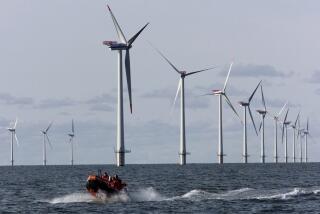Fewer Power Plants Slated; Worries Rise
- Share via
HOUSTON — Electricity producers’ plans to curtail expansion, aimed at reassuring investors rattled by Enron Corp.’s collapse, are raising concerns that the U.S. may face power shortages in the next few years.
Mirant Corp., NRG Energy Inc. and some rival generators shelved or postponed billions of dollars in projects this month to bolster their credit ratings after downgrades helped push Enron into Chapter 11 bankruptcy.
A decline in electricity prices has further reduced the incentive to build plants. The slowdown in construction may lead to tight power supplies as the U.S. economy recovers from recession, possibly next year, and energy demand picks up, investors and analysts say.
“When the economy snaps back, we’re going to have howls again asking, ‘Why didn’t we build more power plants?’” said Donald Coxe, manager of the $352-million Harris Insight Equity Fund. “In 12 months people will once again be predicting an energy crisis and asking why we were so stupid not to build more.”
Enron filed for Chapter 11 protection from creditors Dec. 2 after investors grew concerned that the company, formerly the largest energy trader, was hiding debt at affiliated partnerships. Customers defected as the company’s credit rating was cut to junk status and it couldn’t raise cash needed to back trades.
To avert similar downgrades, Atlanta-based Mirant is slashing capital spending by 40% and Minneapolis-based NRG is delaying $900million in spending on generators. Dynegy Inc., based in Houston, will spend less than $1.5 billion on projects, down from a budgeted $1.7 billion.
“The last thing the market wants to see is a huge expansion program that requires huge cash flow,” said Jeffrey Gildersleeve, an Argus Research analyst. “Management is going ahead with what’s on the table now. The later stuff is being delayed.”
Shares of power traders and producers have fallen as investors fearful of an Enron-like meltdown shy away from debt-laden companies. In the last two months, Mirant shares have slid 43%, Calpine 36%, Dynegy 34% and NRG 14%.
Gildersleeve projected about six months ago that about 320,000 megawatts of generating capacity would be built in the U.S. in the next five years. He now expects 150,000 to 200,000 megawatts.
At least 185,000 megawatts must be added by 2010 to meet U.S. demand, the Department of Energy forecasts. A megawatt is enough power for about 1,000 typical U.S. homes.
The deregulation of electricity markets in the U.S., first in New England and later in the Middle Atlantic states, California and parts of the Midwest, spurred developers such as Calpine and utilities such as Dominion Resources Inc. to break ground on new power plants in the last few years.
Calpine, based in San Jose, added eight plants in the third quarter, quadrupling revenue in the period to $2.92 billion. Duke Energy Corp., the biggest U.S. utility owner, boosted third-quarter net income by 50% to $796 million as power sales rose.
Profit from electricity sales is falling as the U.S. economy slows, in part because of caps imposed by federal regulators in the West to stem soaring prices that drove California’s two biggest utilities to the brink of insolvency.
This quarter, electricity prices at the California and Oregon border dropped to an average of $26.91 a megawatt, down 89% from $244.80 a year earlier.
Calpine said it is now reviewing the company’s plan to increase generating capacity to 70,000 megawatts by the end of 2005, a level that would make it the nation’s biggest electricity producer.
Even with the cutbacks, many energy company executives and analysts say they aren’t worried about shortages. The industry will build plants where needs arise, they say. The western U.S. has added about 5,000 megawatts of capacity this year, an increase of 3%, with almost half coming in California.
“If the players still see a need for power, the plants will get built,” said Thomas Capps, chief executive of Dominion, owner of Virginia’s largest utility.
A lack of transmission lines is more likely to lead to shortages than would a dearth of power plants, said David Schanzer, a utility analyst with Janney Montgomery Scott. In some cities, such as New York and Boston, power lines can get overloaded, leading to blackouts during a heat wave.
More to Read
Inside the business of entertainment
The Wide Shot brings you news, analysis and insights on everything from streaming wars to production — and what it all means for the future.
You may occasionally receive promotional content from the Los Angeles Times.










